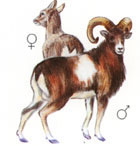
Characteristics
Mouflons are the only big game on Tenerife Island. They were introduced in 1970 for hunting purposes. The estimated current population is 70-125 specimens of questionable hunting quality. They have been hunted with rifles since 1977. Mouflons have no natural predators in Tenerife. The government has strict supervision and control over mouflon hunting. There is a plan to eradicate mouflons in the long term, owing to the damage they cause to protected flora in the Teide Nature Park and the Corona Forestal Nature Park.
Male mouflons weigh around 50-55 kilos. Their horns curve backwards to the point of piercing their backs in some cases. Female mouflons are smaller than the males, weigh around 30 kilos and rarely have horns. Their keen sense of smell enables them to detect hunters easily. In Tenerife, mouflons are distributed along the summits of the northern ridges in Teide National Park and La Corona Forestal, and more often along the summits of the southern strip, at altitudes of 1,400 to 3,100 metres. The entire distribution area is around 371 kilometres. They prefer lava habitats of the rough Malpaís and pahoehoe type (lava tubes).
Mouflons are herbivores that feed on grasses, and are particularly fond of the native plant species that are in a critical state of conservation.
Social organisation and reproduction
The annual breeding season commences with a gathering of males and females in mid-September and culminates when the females come into heat in the autumn. The females gestate for approximately five months. They have only one offspring in April, May or June, which weighs 2 to 2.5 kilos. Groups of adult males and solitary males separate from the groups of females with their young from mid-November to March.
Hunting management
The Council of Tenerife has drawn up a plan to improve the way beats and stalking are organised in mouflon hunts.
Remember:
- Mating season: From the gathering of specimens in mid-September to November.
- Gestation: Mid-November to March. Separate groups of males and females.
- Birth: April, May and June.


 Print
Print